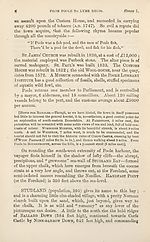Download files
Complete book:
Individual page:
Thumbnail gallery: Grid view | List view

Haute 1.
POOLE HARBOUR.
interior is broken up into numerous shadowy glens and romantic
hills—its shore is rich in the commoner aquatic plants. Queen
Elizabeth erected here a small fortress, which Charles I. consider¬
ably strengthened. It has been visited by the witty and dissolute
Charles II., and by the dissolute but not witty George IV. (when
Prince Regent), and was for a few years the scene of the glories
of Colonel Waugh, then its proprietor, and one of the speculators
involved in the catastrophe of <l the Royal British Bank.” He
occupied the castle, which he furnished luxuriously, recovered a
hundred acres of waste land, opened pits to work the excellent
potter’s clay of which the island is chiefly composed, built a pier,
laid down a tramroad, and erected St. Mary’s Church for the
accommodation of his labourers. How suddenly the golden dream
was dissipated in which this adventurous gentleman had rejoiced,
our readers may remember.
The harbour opens, north, into a land-locked cove or gulf,
called Hole’s Bay, and to the north-west into Lytchet Bay,
whose mouth is spanned by the railway ; while it trends away
suddenly to the south-west into a deep inlet, which stretches for
some miles through the clay-fields up to Wareham. (See
Route 2.)
The historical associations which invest the town of Poole
with interest for the scholar are not numerous. We are told that
it was a Roman station on the Icening road, and afterwards one
of the royal chapelries of the Saxon kings. In 998, the Norse¬
men landed here, and in 1015 king Knut sailed up the harbour,
and pushed on to Wareham. An attack was made upon it by
some Spaniards in 1405, in revenge of the predatory exploits of
a famous buccaneer named Harry Page. The town was walled
in 1443. Hither came Henry of Richmond in 1483, but finding
it garrisoned by Richard’s troops, he returned to St. Malo. During
the civil war it was so stoutly Roundhead in its sympathies, that
Charles II., after his accession, caused its fortifications to be
razed to the ground. The Postern, temp. Richard HI, now
standing in a lane near the quay, is their sole relic. Charles
X. of France landed here, August 23, 1830, on his escape from
Paris, and from hence proceeded to Lxdworth Castle.
In the good old times, the quaint seaside town which over¬
looked such a multiplicity of snug little creeks, became the
rendezvous of the most desperate of the Dorsetshire smugglers.
On one occasion, a band of sixty fellows, armed to the teeth, made
POOLE HARBOUR.
interior is broken up into numerous shadowy glens and romantic
hills—its shore is rich in the commoner aquatic plants. Queen
Elizabeth erected here a small fortress, which Charles I. consider¬
ably strengthened. It has been visited by the witty and dissolute
Charles II., and by the dissolute but not witty George IV. (when
Prince Regent), and was for a few years the scene of the glories
of Colonel Waugh, then its proprietor, and one of the speculators
involved in the catastrophe of <l the Royal British Bank.” He
occupied the castle, which he furnished luxuriously, recovered a
hundred acres of waste land, opened pits to work the excellent
potter’s clay of which the island is chiefly composed, built a pier,
laid down a tramroad, and erected St. Mary’s Church for the
accommodation of his labourers. How suddenly the golden dream
was dissipated in which this adventurous gentleman had rejoiced,
our readers may remember.
The harbour opens, north, into a land-locked cove or gulf,
called Hole’s Bay, and to the north-west into Lytchet Bay,
whose mouth is spanned by the railway ; while it trends away
suddenly to the south-west into a deep inlet, which stretches for
some miles through the clay-fields up to Wareham. (See
Route 2.)
The historical associations which invest the town of Poole
with interest for the scholar are not numerous. We are told that
it was a Roman station on the Icening road, and afterwards one
of the royal chapelries of the Saxon kings. In 998, the Norse¬
men landed here, and in 1015 king Knut sailed up the harbour,
and pushed on to Wareham. An attack was made upon it by
some Spaniards in 1405, in revenge of the predatory exploits of
a famous buccaneer named Harry Page. The town was walled
in 1443. Hither came Henry of Richmond in 1483, but finding
it garrisoned by Richard’s troops, he returned to St. Malo. During
the civil war it was so stoutly Roundhead in its sympathies, that
Charles II., after his accession, caused its fortifications to be
razed to the ground. The Postern, temp. Richard HI, now
standing in a lane near the quay, is their sole relic. Charles
X. of France landed here, August 23, 1830, on his escape from
Paris, and from hence proceeded to Lxdworth Castle.
In the good old times, the quaint seaside town which over¬
looked such a multiplicity of snug little creeks, became the
rendezvous of the most desperate of the Dorsetshire smugglers.
On one occasion, a band of sixty fellows, armed to the teeth, made
Set display mode to:
![]() Universal Viewer |
Universal Viewer | ![]() Mirador |
Large image | Transcription
Mirador |
Large image | Transcription
| Antiquarian books of Scotland > Adventure and adventurers > Black's guide to the counties of Dorset, Devon, & Cornwall > (27) |
|---|
| Permanent URL | https://digital.nls.uk/142586702 |
|---|
| Description | Thousands of printed books from the Antiquarian Books of Scotland collection which dates from 1641 to the 1980s. The collection consists of 14,800 books which were published in Scotland or have a Scottish connection, e.g. through the author, printer or owner. Subjects covered include sport, education, diseases, adventure, occupations, Jacobites, politics and religion. Among the 29 languages represented are English, Gaelic, Italian, French, Russian and Swedish. |
|---|

